< BACK |
NEXT > |
Saskatchewan Scenery Photo Tour
Saskatchewan Wildlife
Most of Saskatchewan is very flat -- so wildlife doesn't have very many places to hide. Most commonly sighted wildlife as you roam around the province are deer, mice, ground squirrels and birds (especially magpies, crows, mallard ducks and Canada Geese).
If you spend a bit of time though, you'll also bump into some of the more interesting animals like coyotes, elk, moose, beavers, garter snakes and even the occasional wolf or black bear.
And, of course, there are loads of insects -- mosquitoes, grasshoppers, bumblebees, wasps, cabbage moths, tent caterpillars and flies.
Photo: Sharp-Tailed Grouse
The sharp-tailed grouse was adopted as Saskatchewan's provincial bird on June 29, 1988.
 Photo:
Beaver
Photo:
Beaver
Beavers can be found in streams and rivers in every province of Canada. Much of the early European exploration and trade of Canada was based on trapping beavers for their inner fur. The many tiny barbs of the inner fur make it excellent for felting, especially for hat making.
Beavers have large flat tails that they use while swimming to help them steer. They also slap it on the water when they see danger as an alarm to warn nearby family members to be on guard or return to the dam.
Beavers have large buck teeth which allow them to chew on wood under water without getting water in their mouths. Their teeth never stop growing – instead they are worn down when they use their teeth to cut wood.
Beavers use the wood they cut to build dams in the water. They live with their families in these dams, tucked safely away from predators. Beavers often build their dam across a river or stream, blocking the water. Over time a pond forms around their dam keeping them nice and safe.
Beaver information and coloring page
Photo: Canada Geese
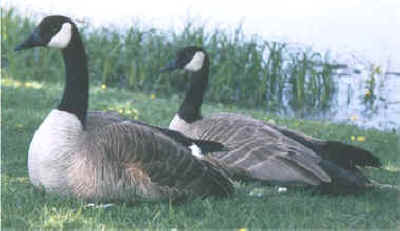
Canada Geese
One of my favorite spring and autumn memories ever since my early childhood was hearing the honk of the Canada Geese. I'd peer up at the sky and look for the telltale V-formation of the flock of geese returning to Canada for the summer or leaving for the winter. This spring, I couldn't help but smile when I noticed my daughters straining their necks in search of the geese.
Canada Goose Coloring Page (with information)
more about the Canada Goose >
 Photo:
Bald Eagle
Photo:
Bald Eagle
Although the Bald Eagle is the USA's national bird, most of it's breeding grounds are located in Canada, including most of Saskatchewan.
The bald eagle is the only eagle exclusive to North America. They are Canada’s largest bird of prey and have no natural enemies.
Bald eagles choose one mate for life. To impress each other, males and females perform special courtship dances in the sky. This dance involves locking their talons together and cart-wheeling through the air.
When a bald eagle loses a feather on one wing, it will lose a feather on the other in order to keep its balance.
Bald Eagle information and coloring page
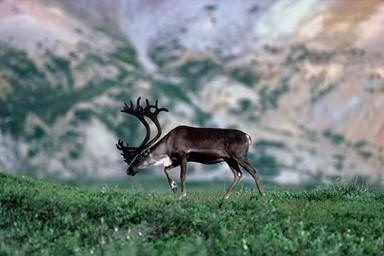 Photo: Caribou
Photo: Caribou
There are 2.4 million caribou in Canada, but many are members of subspecies that are threatened or nearly extinct.
Caribou can be found dwelling in forests, on mountains, in the tundra, and even migrating each year between the forests and northern tundra of Canada. Both woodland caribou and barren ground caribou are native animals to Saskatchewan's boreal forest. Woodland
Caribou have smelly feet! Or close anyways -- scent glands at the base of their ankles that are used when the animal is in danger. It will rear up on its hind legs to release a scent that alerts other caribou in the herd to the danger it is facing.
Caribou information and coloring page
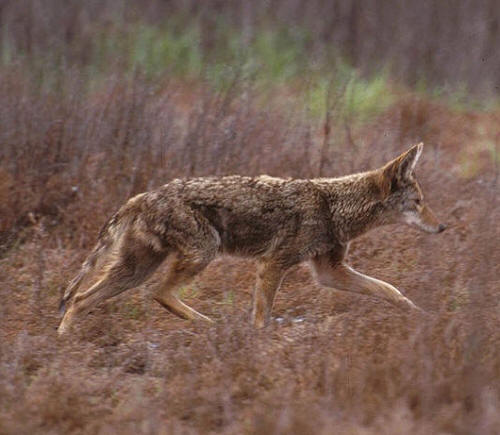 Photo: Coyote
Photo: Coyote
The coyote is a species of canine (like dogs) found throughout Canada with the exception of the coldest northernmost areas. Coyotes are fairly comfortable around humans and often wander into cities and towns.
Coyote groups are known as pack, bands or routs. Though coyotes have been observed to travel in large groups, they primarily hunt in pairs. Typical packs consist of six closely related adults, yearlings and young.
Coyotes are mainly nocturnal (hunting at night) although they can often be seen roaming around during the day.
Here in Calgary, Alberta we see them in the city a few times a year during the spring, summer or fall. And we here them yipping nearly every night all summer.
Coyote information and coloring page
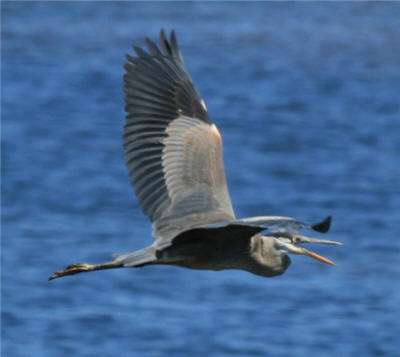 Photo:
Great Blue Heron
Photo:
Great Blue Heron
The great
blue heron is the largest heron in North America -- and
they're actually more grey than blue. These
birds are common through most of North America. Most head south once water begins to freeze.
Some fly as far south as Mexico or Cuba.
The great
blue heron is found near bodies of water including
rivers, lakes and oceans as their main diet consists of
fish. They typically nest on small islands near the
water..
 Photo: Lynx
Photo: Lynx
Lynxes are wild cats that can be found in boreal forests across Canada. They make their dens underneath fallen trees, tree stumps, rock ledges or thick bushes.
The long, round feet of the lynx act like snowshoes by distributing their weight to help them walk on top of the snow. They also have sharp claws that retract helping them to climb, fight predators and capture prey. Their feet are covered in a thick layer of fur to keep them warm in the winter.
Lynxes have dark tufted ears and short, dark bobbed tails.
Lynx information and coloring page
Black-Billed Magpie

The magpie is a member of the crow family (and is just as annoying to farmers). They are extremely intelligent ... Which is really annoying when you're working in your garden. They wait patiently and then pick out all the bean seeds as soon as you're done planting them!!
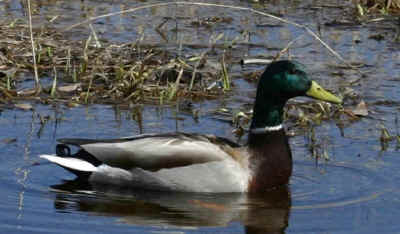
Male Mallard Duck
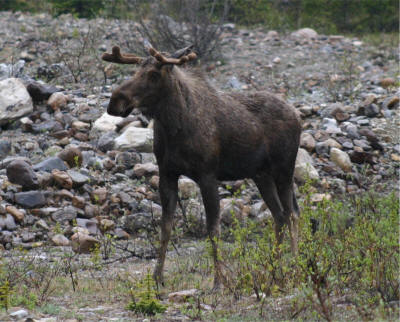 Photo: Moose
Photo: Moose
Moose are
found in every province of Canada - even in Grandma
Doris' backyard! Despite their long
skinny legs, they are powerful swimmers, enjoy eating
vegetation from the bottom of lakes and are typically
found living near bodies of fresh water. Even a newborn
moose is capable of swimming within a few days of its
birth.
Moose don't have very good eyesight, but
they have excellents sense of smell and hearing.
The moose is the largest member of the deer family, and
stands taller at the shoulder than the largest saddle
horse.
Photo: Porcupine
Porcupines are rodents with a coat of sharp quills they use as a defense from predators - although they prefer to run away (or even climb a tree) to escape whenever possible. A porcupine’s quills are actually long strands of hair that have grown together. If one is lost, it will regrow.
Porcupines don't shoot their quills, but they do detach easily when touched. Porcupines may shake their body slightly to embed the quills in an attacker. The barbs in the quills expand from body heat quickly making them very painful to remove. Since attackers tend to attack with their mouths, the quills are often lodged in the tender muzzle area of predators.
 Porcupines live in dens found in rock
piles, caves, fallen logs and trees. They eat the bark from shrubs
and trees and (just like me) their favourite treat is anything salty!
Porcupines live in dens found in rock
piles, caves, fallen logs and trees. They eat the bark from shrubs
and trees and (just like me) their favourite treat is anything salty!
Porcupines are found all across North America and can be found in every province in Canada where they live anywhere there are forested areas or in shruby areas along riverbanks.
And, yes, porcupine can climb trees ... They even take naps in them sometimes.
Porcupine information and coloring page
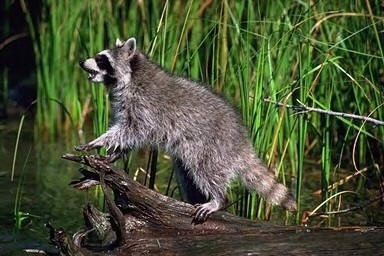 Photo: Raccoons
Photo: Raccoons
Raccoons are best recognized by the black bandit mask across their face and their big, bushy, black-striped tail. Raccoons have nimble fingers which they can use to climb, catch fish and even open garbage cans -- their paws do not have opposable thumbs and thus do not have the agility of the hands of primates.
Raccoons are nocturnal, which means they feed at night. They eat vegetation, insects and small animals. They can live anywhere there is an access to food and water making them very versatile animals. However, they are best suited to living in swamps, marshes and floodplain forests.
Raccoon information and coloring page
 Photo: Snowy Owls
Photo: Snowy Owls
Snowy owls are mainly white
with some black or dark brown markings. Since snowy owls are
found in colder climates, they have a thick layer of down
underneath their many layers of feathers to keep themselves warm
in even the most frigid temperatures.
Snowy owls nest in
the arctic during the time of year when it is daylight for most
of the day. Likely because of this, snowy owls are the only type
of owl that sleep at night and hunt during the day (all other
owls come out at night).
Snowy owls visit every province
of Canada during the winter - they tend to nest and breed
during summer in the more northern areas of the country.
Snowy Owls information and coloring page
 Photo: Striped Skunk
Photo: Striped Skunk
Skunks are best recognized by the white stripes on their black body and tail and of course, their smelly smell. I think the little white stripe above their nose is pretty cute.
They use their scent glands to spray a foul smelling musk for to protect themselves. The spray of a skunk can reach up to six meters and the horrible smell is strong enough to be carried almost one kilometre by the wind.
Skunks prefer open areas of mixed forests and grasslands, typically living in dens abandoned by other animals. They can also live under porches - including ours! If you ever want to get rid of a skunk, just leave lights on near their den during the night. Skunks are nocturnal animals and don't like porch lights *grin*.
Skunks live throughout Canada, spending the winters sleeping in deep dens.
Skunk information and coloring page
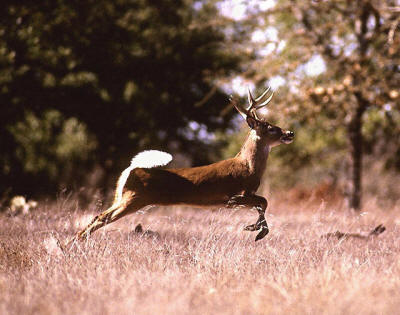 Photo: White-Tailed Deer
Photo: White-Tailed Deer
The white-tailed deer is the
most common of all of North America’s large mammals and can be
found throughout Canada. They prefer grasslands to forest - the
clearing of land for agricultural purposes is favourable for
them.
The
white-tailed deer is tan or reddish-brown in the summer and
grayish-brown in the winter, with certain areas, including the
tail, remaining white all year round
The
deer is a great jumper and runner. It can reach speeds of up to
58 kilometres per hour. They can make vertical leaps of over two
and a half metres and horizontal leaps of nine metres — that’s
almost as long as a school bus.
White-tailed Deer information and coloring page
 Photo: Wolves
Photo: Wolves
Wolves are the largest wild member of the dog family. Although they have been exterminated from many areas of the world, wolves can still be found throughout the northern regions of Canada. Unlike many of the animals mentioned here, they are extremely uncommon wild animals to bump into.
There is only one pack of wolves that resides in Saskatchewan (near the Flin Flon area). This pack migrates between Saskatchewan and Manitoba following the caribou herds.
Wolves live in packs of up to ten members which always have an alpha male and breeding female. Much of the wolf packs "play" takes place to reinforce the hierarchy of the group – very little real fighting occurs within the pack.
Wolves work together as a pack to catch prey they would not be able to hunt alone. This cooperation them dangerous and effective predators.
Wolves information and coloring page
